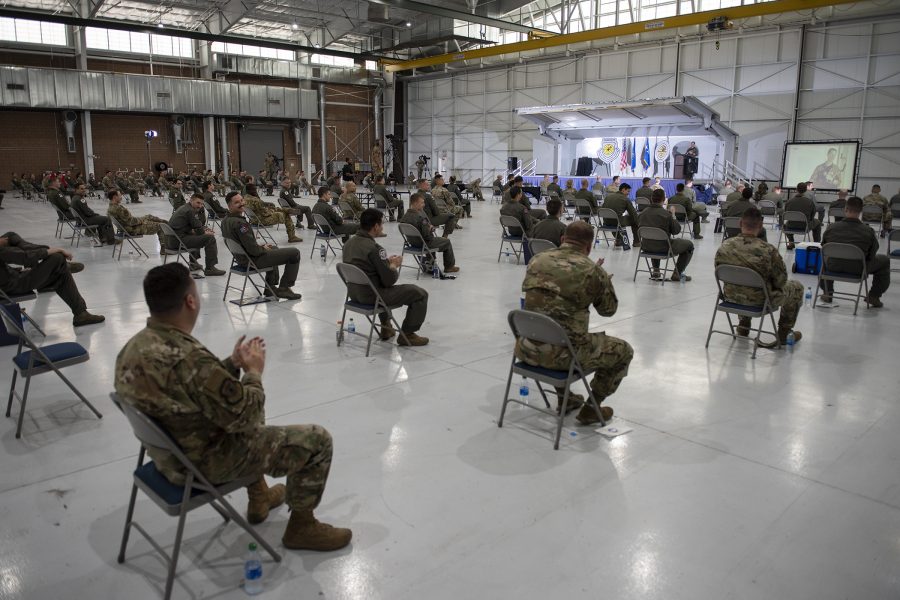The U.S. Air Force Weapons School kicked off its latest class on July 7 by testing its newest cohort of students—Class 20B—for COVID-19 antibodies, its commandant, Col. Jack Arthaud, told Air Force Magazine in a July 10 interview.
“We’re testing for antibodies across the entire student population, and then, if anybody tested positive … we did a rapid COVID test to see if they had an active infection,” he said, adding that no active infections were detected.
As an additional preventative step, he said, any students who headed to Nellis Air Force Base, Nev., from bases outside of the continental U.S. had to quarantine for two weeks before starting class.
“And so we’re one week into class so far, and as of now, we’re again, continuing operations trying to balance accomplishing the mission while also protecting the health of our cadre, students, and families,” he said.
The school, which Arthaud said is tasked with building “expert teachers who can lead combat readiness across our Air Force and Space Force,” conducts two classes that include both Weapons Instructor Course and Advanced Instructor Course students annually, with the first stretching January to June, and the second running from July until December.
“The USAF Weapons School teaches graduate-level instructor courses that provide the world’s most advanced training in weapons and tactics employment,” the Air Force writes. “During the course, students receive an average of 400 hours of graduate-level academics and participate in demanding combat training missions.”
When the pandemic hit during the school’s first 2020 class—named 20A—it “totally redesigned” the way it operated, Arthaud said.
“We had a few cases that originated from outside of work, and as a result, we stood down one of our squadrons for two weeks,” he said.
In that case, while a cadre member tested positive for the virus, the school was able to isolate the patient, and no one else from the unit contracted it.
A false alarm also wound up halting another unit’s mission for a week, he said.
“We had one other case in the last class where we had somebody who had COVID symptoms who was tested for it, and when we did the contact tracing, we chose to shut down the whole squadron, as well, while we waited for results,” Arthaud said. “But in that case, it took about four or five days to get the results back, and when those results came back negative, then we recontinued operations.”
On top of executing Centers for Disease Control and Prevention guidance about face coverings and social distancing, the school utilized “a teaming concept” to reduce the potential risk of COVID transmission and ensure its operations didn’t miss a beat, he said.
“The colors of our wing are black and gold, so we had a black team and a gold team, and they would alternate when they would come in on work so we could minimize the potential for transmissions across teams, and it gave us a continuity of operations such that if one of the teams was infected, we could isolate those folks and continue the training for the other team,” he said.
He said the entire wing now follows this teaming plan, including the 57th Maintenance Group, which he praised as having done “a phenomenal job” using the strategy to keep producing training-essential aircraft sorties for the school amid the pandemic. While he said these sorties were produced “at a slightly reduced rate,” they succeeded in meeting the school’s “high standards and … training requirements.”
Squadron commanders are also letting their team members telework when possible, he noted.
When all was said and done, Class 20A graduated in June with zero COVID-related casualties—either due to illness or “loss of training”— he said.
“I think what we’ve learned is that, because the Weapons School is so diverse … there is no one-size-fits-all policy, other than kind of the overarching CDC guidance of social distancing; good, hypervigilant personal hygiene; and then using the basics of anybody who’s sick or symptomatic staying home, and then aggressive contact tracing and isolating those folks to minimize the spread and minimize the mission impact,” he said. “I think those fundamentals are really what applies at a broad level.”
Editor’s Note: This article was updated on Aug. 5 at 2:30 p.m. EDT to clarify how Weapons School classes are structured.

